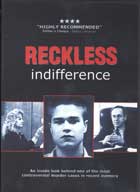
Reckless Indifference 2000
Distributed by Choices, Inc., 3740 Overland Ave., Ste. F, Los Angeles CA 90034; (310) 839-1500
Produced by Dale Rosenbloom and William Gazecki
Directed by William Gazecki
DVD, color, 94 min.
Jr. High - Adult
Criminal Justice, Adolescence, American Studies
Date Entered: 12/12/2006
Reviewed by Maureen Puffer-Rothenberg, Valdosta State University, Valdosta, GAReckless Indifference examines the 1995 stabbing death of sixteen-year-old James “Jimmy” Farris, Jr., and the subsequent criminal trial that sent four other boys to prison for life.
On May 22, 1995, Farris and Mike McLoren, 17, were in McLoren’s backyard in Agoura Hills, California, outside a shack McLoren called his “fort.” Local teenagers routinely visited the fort to hang out, drink and smoke pot, which they bought from McLoren. Shortly after suppertime five boys pulled up in a pickup truck across the street; four got out and approached the fort. Jason and Micah Holland, Brandon Hein, and Tony Miliotti ranged in age from fifteen to eighteen; they had been drinking and had come either to buy pot from McLoren or to steal it. Within minutes a fight broke out inside the darkened shack and eighteen-year-old Jason Holland stabbed both McLoren and Farris with a pocketknife. McLoren survived, but Farris bled to death from a wound to the heart.
Investigators gave McLoren immunity for possession of drugs and for his involvement in the brawl, provided he testified against the other boys in court. Under California’s felony murder rule, if someone dies during the commission of a felony (such as a robbery), all involved are criminally responsible regardless of who actually committed the murder or whether there was an intent to kill. Prosecutors argued successfully that the boys intended to steal electronic equipment from McLoren’s fort; therefore Farris was killed during an attempted robbery.
Seventeen-year-old Chris Velardo, who drove the boys to the fort but did not participate in the brawl, made a deal with prosecutors and accepted a maximum 12-year prison sentence. Jason Holland admitted to stabbing Farris and McLoren and was convicted of first-degree murder—along with Micah Holland, Brandon Hein and Tony Miliotti. Jason Holland, Hein and Miliotti were sentenced to life in prison without parole; Micah Holland, a minor in May 1995, was sentenced to twenty-five years to life.
Director William Gazecki obtained interviews with an impressive number of people close to the case, including Jimmy Farris’ parents Judie and James Sr. (a Los Angeles policeman), members of the convicted boy’s families, reporters who covered the case, a private investigator, several attorneys on both sides and legal expert Alan Dershowitz. Of the convicted boys, only Brandon Hein is interviewed on camera.
The prosecutors and the Farris family believe justice was done. Others argue against the application of the felony murder rule and describe misconduct on the part of prosecutors, other court officials, police detectives and the press; the boys’ supporters allege that James Farris, Sr. was inappropriately involved in the investigation. Hein’s attorney believes prosecutors and the court made an example of the Farris case in response to political pressure following the O.J. Simpson and Menendez trials.
While Gazecki provides a wealth of information from both prosecutors and the defense, and a solid explanation of the felony murder rule, the film is overlong and repeatedly makes the same points. Interviews are cut into brief sound bites and further intercut with reenactments, still photographs (many shown more than twice), shots of newspaper headlines, courtroom footage and scenes of the Agoura Hills neighborhood. Repetition gives the film an amateurish and low-budget quality. Courtroom and neighborhood footage is slowed to create drama; local teenagers are not interviewed but appear primarily in slow-motion from the hips down, as if their clothing alone signals a hidden menace.
Although Gazecki’s examination of the case is more than thorough, its broken narrative and too-often recurring images are reminiscent of tabloid-style true-crime television. Although not a high-quality effort, the film might be of interest to criminal justice students, and can be recommended for its detail and for Gazecki’s access to major figures in the case.
Awards:
- Golden Satellite Award, Best Motion Picture, Documentary